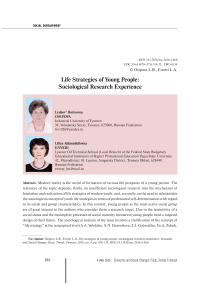Life strategies of young people: sociological research experience
Автор: Osipova Lyubov Borisovna, Enveri Liliya Akhmedullovna
Журнал: Economic and Social Changes: Facts, Trends, Forecast @volnc-esc-en
Рубрика: Social development
Статья в выпуске: 4 (46) т.9, 2016 года.
Бесплатный доступ
Modern reality is the world of formation of various life prospects of a young person. The relevance of the topic depends, firstly, on insufficient sociological research into the mechanism of formation and realization of life strategies of modern youth; and, secondly, on the need to substantiate the sociological concept of youth life strategies in terms of professional self-determination with regard to its social and group characteristics. In this context, young people as the most active social group are of great interest to the authors who consider them a research target. Due to the transitivity of a social status and the incomplete processes of social maturity formation young people need a targeted design of their future. The sociological analysis of the issue involves a clarification of the concept of “life strategy” at the conceptual level (A.A. Volokitin, S.N. Ikonnikova, E.I. Golovakha, Yu.A. Zubok, V.T. Lisovsky, M.N. Rutkevich, G.V. Leonidova, K.A. Ustinova, etc.)...
Young students, social group, social maturity, life strategy, life prospects
Короткий адрес: https://sciup.org/147223850
IDR: 147223850 | УДК: 316.6 | DOI: 10.15838/esc.2016.4.46.6
Текст научной статьи Life strategies of young people: sociological research experience
The modern world provides great opportunities for the formation of various life strategies of a person. On the one hand, there is a wide range of opportunities for self-determination, individual freedom in self-actualization, individual initiative and creativity; on the other hand, there is a growing problem of survival related to the process of social differentiation of the population, the loss of social guarantees, the increase in social tensions and the decrease in the standard of living [2, p. 217]. Significant shifts in young people’s public consciousness occur on the background of these transformation processes. Despite a relatively high level of young people’s social optimism, they express their dissatisfaction with the declining quality of life which has become more apparent in recent years; favor the reform of the improvement of the socioeconomic wellbeing of the country and the formation of civil society [5, p. 17]. Amid global social changes the study of young people’s life prospects is becoming relevant due to a number of circumstances.
First , due to the reduced role of traditional institutions of socialization and value modification.
Second , young people ensure the development of society, therefore the study of their life strategies becomes the most important indicator which helps predict further social processes and development trends.
Third , there is a deformation of the age structure, which indicates the beginning of depopulation process.
Finally , the process of social differentiation leads to the change in young people’s status in society, which is manifested in the growth of unemployment among the youth and in reduced prospects in social growth and professional self-actualization.
The concept of “life strategy” holds a special place in the conceptual framework and is used in different contexts. Its primary purpose is to implement long-term interrelated actions aimed at achieving the desired result. The content of life strategy is a set of rules for decision-making used to determine activity directions. Unfortunately, the majority of young students is not capable of strategic rebuilding of their future and prefers to “go with the flow” and “live in the present”.
It is known that life strategy1 implies a high level of organization of the culture of living. Life strategies are the research target of a wide range of scientific knowledge, in particular philosophy, psychology, social studies, cultural anthropology, etc. Each of them examines a particular aspect of formation and implementation of personal life strategies. However, with all the diversity of scientific research, the problem of life prospects formation remains theoretically and empirically under-explored and the definition of the given scientific category lacks logical precision and clarity ( tab. 1 ).
According to the interpretations of the term presented in table, the formation of life prospects of young students is influenced both by external factors, involving changes in the scope of their activity and internal factors, manifested in the change of value identity and the design of academic and professional plans. Our position resonates well with the opinion of local researchers, T.E. Reznik and Yu.M. Reznik, who claim that life strategy is a dynamic system characterized by a well-designed scheme of value orientations, goals set on their basis, and the meaningfulness of behavioral attitudes. It is safe to say that the identification of a life trajectory of a young person is a purposeful process of the realization of the concept of life, the success of which primarily depends on the level of a person’s social activity and responsibility acceptance. This is confirmed by L. Hjelle, who also emphasizes that each person’s development in this direction is unique [21, p. 307]. A similar position is expressed by E.I. Golovakha, who stresses that “life prospects should be considered as a holistic image of the future” [3, pp. 266–267]. It is generally accepted that amid the turbulent state of the society young people are characterized by divergent life strategy realization vectors and lack of life meaningfulness and clarity of attitude formation.
In order to study life prospects of young students in 2015 an author’s research was conducted in three municipalities of the Khanty-Mansi Autonomous Okrug (Ugra), including Surgut, Lyantor and the settlement of Nizhnesortymskii. In order to conduct comparative analysis, analytical materials on the Khanty-Mansi Autonomous Okrug have been used, which are presented in the report
Table 1. Life strategy is …
The choice of a social group of young students as a research target is justified by its extremely heterogeneous composition. It is known that this age is characterized by the physiological maturation, the social development of the personality, the educational process and the establishment of a future professional activity foundation and life trajectory [4, p. 148]. Moreover, this group is marked by a diversity of functions, roles and social statuses which correspond to the stages of personality growth. The objectives set by the sociological research are as follows:
-
• identification of social well-being of young students;
-
• study of academic plans of young people;
-
• prediction analysis of professional strategies of Ugra young people.
According to official statistics, the number of general population estimated 368.8 thousand of Ugra young people. The sample size consisted of 750 people aged 15–18 (inclusive): in Surgut – 457 people, in Lyantor – 225, in the settlement of Nizhnesortymskii – 68 people. When selecting the respondents, quota sampling and target demographic methods have been used. The sample is representative, the structure of the sample population by place of training and dwelling corresponds to the structure of the sample population.
On order to attain the objectives the following research methods have been used: questionnaires, expert interviews, content analysis. Fifty-seven experts took part in the expert interview – teachers of educational institutions and active members of parent community.
The term “young people” is a well-known social category; however, it does not have a single interpretation, especially in terms of age limits of this socio-demographic group. In the Russian Federation a youth is a young person aged 14–30 (in Europe – 15–29). This study adheres to theoretical and methodological approaches which present young people as the “most active social group aged 14–30 and characterized by a high level of social mobility, intellectual activity and health, which distinguishes it from other social groups and helps quickly adapt to modern living conditions” [9, p. 102]. Nowadays there are about 35 million young people in Russia, which amounts to approximately 25% of the total population of the country2. Young people certainly play a significant role in the development of the modern society. First, they are a source of innovative ideas and a huge amount of energy for transformation processes. Second, they put new creative ideas into practice [17, p. 10]. This is confirmed by V.T. Lisovskii, who claims young people to be “an important subject of social changes, a huge innovative force on which depends the welfare of the society” [7].
Figure 1. Number of young people aged 14–30 in Russia, million people
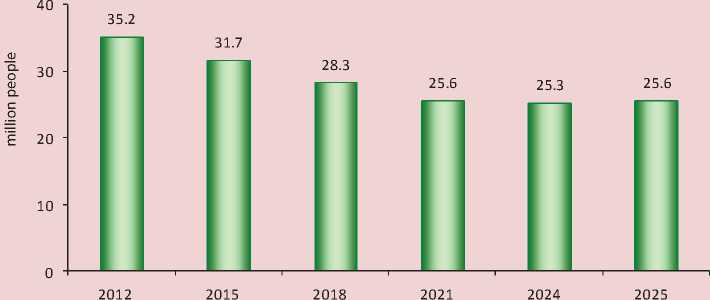
Source: Demographic forecast of the Federal State Statistics Service up to 2030.
The Federal State Statistics Service demographic forecast for young people up to 2030 is disappointing: statistical indicators confirm that Russia will experience a sharp reduction in the number of young people – from 35.2 million in 2012 to 25.6 million people in 2025, i.e. by 27.3% (Fig. 1) .
The results of international research of the position of young people in Russia are alarming. In 2013 the Russian Federation was ranked the 88th among 170 countries on Youth Development Index (YDI)3.
In this situation it becomes obvious that the economic and social burden on the Russian youth will increase in the near future. The process of youth population reduction may lead to the deepening problem of the formation of human resources which are able to increase the intellectual and technological capacity of the country and reduce highly qualified personnel training, which will result in the growing external technological dependence of Russia. In this regard, the state policy should be focused on solving the key problem of ensuring an intensive growth of human capital and, consequently, improving the quality of life.
The Russian Federation demographic policy Concept for the period up to 2025 emphasizes the need of including objectives and activities aimed at improving the demographic situation into federal and regional programs of the socio-economic development of territories. At the same time the Concept raises the need to minimize physical and social losses and the issue about the most profound and effective socialization of young people, the development of traditional values and the creation of opportunities for positive youth development.
The Khanty-Mansi Autonomous Okrug is one of the “youngest” regions of the Russian Federation ranked the 8th. The characteristic feature of the okrug is the stability of its demographic development which is provided by the youthful age structure of the population (Tab. 2) .
The average age of Khanty-Mansia residents in early 2015 was 34.1, which is 5.3 years less than the average age of the Russians (39.4). The share of people below working age in the country’s social structure is 22.4%, which is 4.7 percentage points higher than the national average (17.7%). There is also an annual growth of birth rate indicators in the autonomous okrug, which positively affects the natural population growth and ensures a stable economic and financial situation of the territory (Tab. 3).
The distinctive social quality of the youth is their ability to participate in active transformation of the society. It should be noted that young people in the context of transformational changes are more flexible in responding to social changes, more aware of the processes occurring in various
Table 2. Youth demographic indicators in the Russian Federation and the Tyumen Oblast, %
|
Federal subjects of Russia |
2012 |
2015 |
||||
|
Number of young people aged 14–30, people |
Population, people |
Proportion of youth population in total population, % |
Number of young people aged 14–30, people |
Population, people |
Proportion of youth population in total population, % |
|
|
Tyumen Oblast |
398254 |
1571546 |
25.34 |
342617 |
1748409 |
19.60 |
|
Khanty-Mansi Autonomous Okrug |
398254 |
1571546 |
25.34 |
342617 |
1748409 |
19.60 |
|
Yamalo-Nenets Autonomous Okrug |
141894 |
564311 |
25.14 |
133363 |
644980 |
20.68 |
|
Russia |
35226771 |
143902170 |
24.48 |
25639217 |
143204049 |
17.90 |
Source: Federal State Statistics Service demographic forecast up to 2030.
Table 3. Demographic indicators dynamics of the population in the Khanty-Mansi Autonomous Okrug, people
The empirical research of young students’ self-actualization consists of three blocks. The first block includes the indicators of social well-being. The second – the results of youth academic plans research in the Khanty-Mansi Autonomous Okrug. The substantive basis of the third block is formed by young people’s professional preferences representing the future life attitude. The article considers each block separately and in detail.
Problems and social well-being of the youth of the autonomous okrug
The concept of “social well-being” characterizes the general attitude of a person, their life assessment, its comfort or discomfort. The contemporary society crisis period in many spheres of life creates many problems for modern youth. Against the background of transformational changes they experience the feeling of insecurity and lose confidence in the future; their psychological stability declines, their social attitudes change and social tensions emerge.
Social well-being is a complex sophisticated system interacting with various processes and mechanisms of purposeful activity of an individual, which have an impact on their development. It is important to study the social well-being of young students because of their social, age and psychological characteristics, as they are most susceptible to external influence.
During the questioning, the respondents were asked a question: “Does your future seem promising to you?” According to Table 4 , positive attitudes of most respondents are explained by the fact that these young people are still dependent on their parents and have not yet faced the difficulties of independent living. Thus such positive attitude is attributed to their age peculiarities.
One of every two respondents is confident about their future prospects. Such positive approach is explained by the mobility, optimism and loyalty of the representatives of this age group. Moreover, their attitude
Table 4. Expectations of Ugra youth, % (“Does your future seem promising to you?”)
|
Variant |
2015 |
|||
|
Surgut |
Lyantor |
Nizhnesortymskii |
Khanty-Mansi Autonomous Okrug |
|
|
Yes |
43.5 |
38.9 |
48.8 |
49.7 |
|
No |
31.4 |
29.7 |
37.4 |
35.8 |
|
Not sure |
22.1 |
27.1 |
10.8 |
18.4 |
|
No answer |
3.0 |
4.3 |
3.0 |
6.1 |
Compiled from: analysis materials of the Socio-Political Analysis and Public Affairs Committee of the Khanty-Mansi Autonomous Okrug Governor’s Office; the results of the author’s sociological research (Surgut, Lyantor, Nizhnesortymskii).
to the current social changes is less sophisticated than that of the older generation. However, the share of respondents pessimistic about their future is about 1/3 in each territory. This is attributed to the difficulties of adaptation to modern living conditions and negative socio-psychological expectations of young people.
It should be noted that the components of the social well-being index of the age cohort under study are represented by the seven indicators which depend on balanced and optimal living conditions, such as family relations and its economic well-being, academic achievements, health behavior, relationships with peers, participation in social activities and emotional state of adolescents.
Table 5 presents the respondents’ answers to the question “How satisfied are you with the following aspects of life?” The analysis has revealed that the majority of respondents is satisfied with the aspect of family relations and partly satisfied with their families’ economic welfare. A quarter of the respondents positively assess their academic achievements, health behavior and emotional state. At the same time it is particularly disturbing that only one out of six respondents positively evaluated their participation in the activities of public organizations. In general, judging by the results of the research, the proportion of respondents dissatisfied with certain aspects of life is small, which is certainly a good trend.
Table 5. Opinions of young people about their satisfaction with various aspects of life, %
|
Indicators |
2015 |
|||||||||||
|
Surgut |
Lyantor |
Nizhnesortymskii |
Khanty-Mansi Autonomous Okrug |
|||||||||
|
Q |
s |
Q |
s |
Q |
s |
Q |
||||||
|
Academic achievements |
25.4 |
67.6 |
7.0 |
25.4 |
67.6 |
7.0 |
22.0 |
59.8 |
18.2 |
27.4 |
63.6 |
9.0 |
|
Family relations |
64.0 |
27.5 |
8.5 |
65.0 |
28.3 |
6.7 |
63.3 |
30.2 |
6.5 |
60.5 |
31.0 |
8.5 |
|
Health behavior |
44.3 |
46.4 |
9.3 |
45.3 |
46.4 |
8.3 |
36.8 |
53.3 |
9.9 |
49.1 |
41.0 |
9.9 |
|
Participation in social life |
16.0 |
73.0 |
11.0 |
15.5 |
73.5 |
11.0 |
16.2 |
73.5 |
11.0 |
15.5 |
73.5 |
11.0 |
|
Emotional state |
57.1 |
35.1 |
7.8 |
55.0 |
39.5 |
5.5 |
38.3 |
53.9 |
7.8 |
55.0 |
37.2 |
7.8 |
|
Family’s economic well-being |
28.0 |
40.2 |
31.8 |
39.1 |
34.2 |
26.7 |
29.4 |
46.8 |
23.8 |
26.4 |
44.8 |
28.8 |
|
Relationships with peers |
37.2 |
49.6 |
13.2 |
37.2 |
49.6 |
13.2 |
30.8 |
60.8 |
8.4 |
37.2 |
49.6 |
13.2 |
Complied from: analysis materials of the Socio-Political Analysis and Public Affairs Committee of the Khanty-Mansi Autonomous Okrug Governor’s Office; the results of the author’s sociological research (Surgut, Lyantor, Nizhnesortymskii).
The economic behavior of young students is usually determined by a complex interaction of their consciousness and objective reality. Radical changes in the modern society inevitably affect the peculiarities of value consciousness and behavioral attitude formation, the strategy of youth as a subject of the labor market. In these circumstances, it is important to gauge the attitude of young students at the beginning of their socio-professional actualization to economic transformations of the region. As can be seen (Fig. 2), young students are more loyal to the issues of the forming regional economy. A quarter of the interviewed young students of educational institutions believe that the transformation of the economic sector of the okrug provides an opportunity for business development and earning a lot of money.
From the point of view of the informants the transition to a market economy has led to the loss of young people’s social guarantees and the risk of becoming unemployed. Therefore, young people’s consciousness is directly affected by social market economy
Figure 2. Young students’ attitude to the results of economic transformations in the Khanty-Mansi Autonomous Okrug, %
Freedom for entrepreneurship
Opportunities for earning money
Economic dependence on private business
Unemployment risks
Prospect for living жить in a free society
Loss of social guarantees
Reduced quality of life
Other
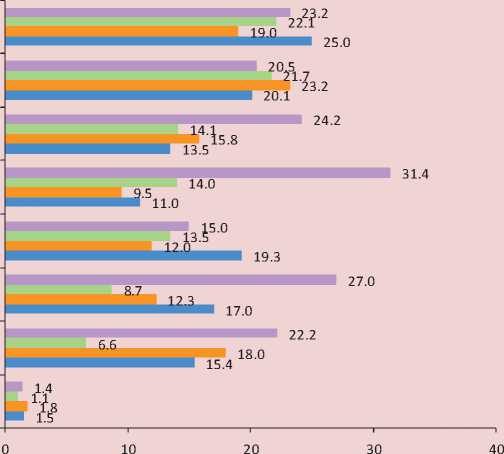
Khanty-Mansi Autonomous Okrug Surgut Lyantor Nizhnesortymskii
Source: analysis materials of the Socio-Political Analysis and Public Affairs Committee of the Khanty-Mansi Autonomous Okrug Governor’s Office; the results of the author’s sociological research (Surgut, Lyantor, Nizhnesortymskii).
formation aspects which, for various subjective and objective reasons, do not always form an adequate attitude of young people to work and active involvement in market relations.
Young students’ academic plans
A strategic priority in the development of the educational system of the autonomous okrug is to create conditions for competitive citizens training in accordance with the socio-economic needs of the okrug. In the sphere of general education there are 309 municipal, 23 state and 5 private educational institutions equipped with modern facilities in accordance with the educational system modernization (Fig. 3).
The availability of school education by enrolment rate in the okrug is higher than the national average and corresponds to the average rate by a comparable group of regions. This indicates that almost all adolescents of the Khanty-Mansi Autonomous Okrug are involved in the system of general education. Education provides opportunities for young people’s self-actualization reflected at the level of their mentality and formation of behavioral attitudes.
Nowadays in the labor market there is a growing demand for a personality possessing fundamental knowledge and professional qualifications, skills of constructive search when addressing production objectives, a high level of creative and analytical thinking. This is confirmed by the graduates of educational establishments, being convinced that in order to achieve a high social and professional status and success in life high-quality knowledge is required.
Figure 3. Coverage of general secondary education by stage, %
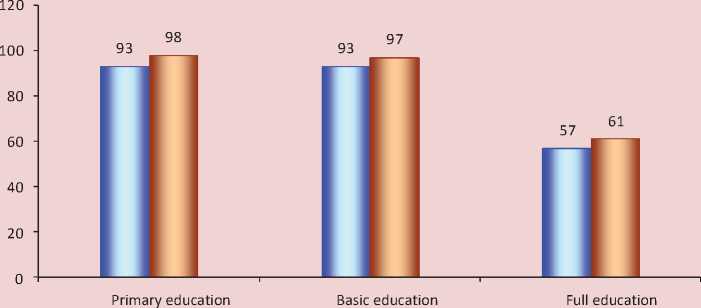
о Russia □ Khanty-Mansi
Source: Education development Strategy of the Khanty-Mansi Autonomous Okrug up to 2020.
Academic plans of the graduates of educational establishments in Surgut and the Surgut region are presented in detail in Table 6 .
The survey results revealed both common features and peculiarities of young students’ academic plans. According to the table, plans for further education are different and are among the main intentions of the graduates of educational establishments. The academic orientation of the respondents is mostly focused on higher education – young people seek to increase their competitiveness in the labor market. As confirmed by the results of the research, training in the system of secondary vocational education prevails to a greater extent among the respondents of Surgut and Lyantor: there are institutions of this category in these areas.
Nowadays young people are aware that knowledge and skilled labor is getting more valuable in the labor market. There is a certain inertia element in further education, as young people deliberately extend the period of their study in an attempt to avoid rough conditions of the real labor market. A small proportion of graduates of educational establishments are planning on taking courses. Unfortunately, nowadays there are no mechanisms for the implementation of a regional model of social partnership of business and professional education in the field of professional training. Defining education as an important life value, young people during the survey expressed their dissatisfaction with the level of education received in educational establishments – 21.3%, 36.7% of respondents are only partially satisfied, 32.9% – are satisfied and 9.1% of respondents found difficulty in replying. About a half of the respondents (48.7%) expressed their hope that in the future they will become professionals and qualified specialists [21, p. 79]. The school system is intended to form socially significant qualities of the younger generation, in particular, common culture and the ability to adapt to modern living conditions.
Table 6. Academic preferences of graduates of educational establishments, %
|
Variant |
2015 |
||
|
Surgut |
Lyantor |
Nizhnesortymskii |
|
|
Higher educational establishment |
73.0 |
68.2 |
66.5 |
|
Secondary vocational education |
21.3 |
24.1 |
17.6 |
|
Combining work and education |
2.2 |
3.9 |
6.8 |
|
Educational courses |
0.5 |
0.9 |
3.2 |
|
Employment |
1.2 |
2.2 |
3.9 |
|
Military service |
1.8 |
1.0 |
2.0 |
|
Compiled from: the results of the author’s sociological research. |
|||
Figure 4. Experts’ opinions on the role of educational establishments in the development of youth, %
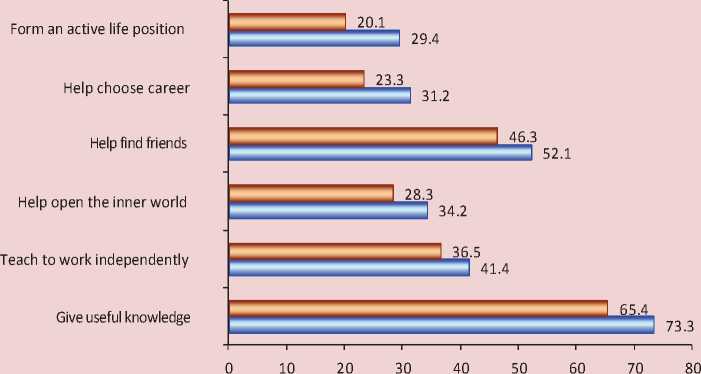
□ Members of the parent community □Teachers
Compiled from the results of author’s sociological research.
The opinion of teachers and members of the parent community was of particular interest in the study, as they act as experts and evaluate the role of educational system in a graduate’s personality development. According to the members of the parent community, a modern educational institution contributes to the formation of these socially important qualities “at the average level”. This applies in particular to the formation of young students’ vocational orientation. Teachers’ evaluations were slightly better. According to the survey results, 65.4/73.3%4
of experts (Fig. 4) confirm the usefulness of knowledge provided by the educational system and at the same time indicate the presence of old roles and functions of school education despite the introduction of the Federal State Educational Standard (FSES) into the educational process. Experts believe that the educational system is changing rather slowly still focusing on the transfer of useful knowledge.
Experts’ evaluations in relation to students’ independent knowledge acquisition are very disappointing (36.5/41.4%), as well as in terms of the socializing influence of educational establishments on the personality (23.3/31.2%) [14, p. 79]. The parent opinion monitoring about the quality of educational services revealed that the most important is fundamental knowledge acquisition (43%), the acquisition of knowledge for personal development (38%), knowledge in demand in the modern labor market (24%), the introduction of innovative educational technologies into the educational process (23%), the high level of professional competence of the teaching staff (35%).
Consistent with the logic of current changes in the educational process, it is quite reasonable to appeal to the teachers’ opinion. According to the qualified teachers, the personality aspect of education involves the development of individual abilities and certain qualities of the students’ personality. The educational process which develops students’ personality, provides for equal “teacher – student” relations. Internal motivation provides the student’s activity with energy, optimism and purpose. The majority of qualified teachers identify the following qualities of modern graduates: pragmatism (42%), egocentricity (36%), ambitiousness (29%), determination (16%) and successfulness (27%). As can be seen, priority is given to a “pragmatic” student. The obtained results are attributed to the socioeconomic changes of contemporary society. According to the teachers, today’s students need to master organizational skills – to analyze and plan their activity. Expanding horizons, increasing the level of cognitive independence and intellectual development should become a priority among modern graduates’ activity directions. The vast majority of teachers consider today’s student to be reflective, constantly dealing with a large amount of information, which causes a lot of cognitive problems and develops cognitive capacity (from reproductive to transformative). The use of interactive educational technologies in the educational process changes the position of the pupil, forcing him\her to think, improvise and use intelligence. Thus, experts agree that in order to improve the quality of learning it is necessary to choose the methods and forms of educational process management which best fit the goals of personality development.
Young people’s professional identity
In the life of a young person vocational choice is an important step, on which depend the success in life and the process of realization of personal potential. Graduate’s vocational choice is exposed to a number of factors: parents – 32.3%, the media – 6.2%, the educational system – 17.2%, friends – 18.2%, the rating and the geographical position of the institution – 12.1% and 14.0% respectively.
Various motives for getting vocational education are the basis for formulating academic plans of the respondents (the respondents were invited to choose three variants). The dominant motives for a large part of the respondents were “getting a profession” (62.3%), “high earnings” (45.5%)
and “career opportunities” (39.4%). The respondents expressed their appreciation for the high-quality educational level as access to getting vocational education (48.1%) and the condition for the realization of potential opportunities (32.3%). It is necessary to pay attention to the fact that getting education is not only a means of achieving financial security for 1/3 of the respondents. The performance indicators of this process include the satisfaction with choice of the field of study and educational establishment, a clear view of one’s social status directly connected with the profession, and the possibility of further employment. However, when choosing a profession, young people are mostly guided by calculation. It has been revealed that subjective value is refracted in assessments of occupational prestige (60.2%). Unfortunately, only one in every five respondents (24.2%) is interested in the content of future professional activity. When entering the labor market, young people are dominated by idealistic visions of future employment, which contradict the real situation in the labor market. A graduate chooses the field of study on the basis of the ideal vision of the future desired employment without considering the real situation in the labor market. This leads to further serious imbalance between labor demand and supply.
However, about a half of the respondents (47.2%) are confident about their future employment after receiving vocational education, a quarter of the respondents expressed concerns on this matter, 16.0% already know what their future employment will be, 11.8% are still confused by this problem. It should be emphasized that professional attitudes of the respondents directly depend on the social support of the family. Thus the respondents from financially secured families are more optimistic about their chances for admission to the university. 62.3% of teenagers from the families of executives are focused on higher education, 59.1% – from the families of qualified professionals, 56.4% – from the families of entrepreneurs, 41.2% – from the families of the working class. Therefore, professional identity of the graduates of educational establishments to a certain extent takes into account such factor as the social status of the family [23, p. 108]. Everyday practice confirms that if the profession is selected in accordance with the interests of the individual and the needs of the society, labor becomes a source of joy, inspiration and provides maximum benefit for the person.
The top five professions are a businessman, a lawyer, an economist, an engineer and a doctor (Fig. 5) . Less popular and demanded among young people are professions of the construction sector. Oil and gas industry also presents low rates [4, p. 144]. In the column “Other” high school students gave polar responses: “go to college”, “work”, “everyone studies”, “for the diploma”, etc. The preliminary choice of the professional sphere of half of
Figure 5. Students’ professional preferences, %
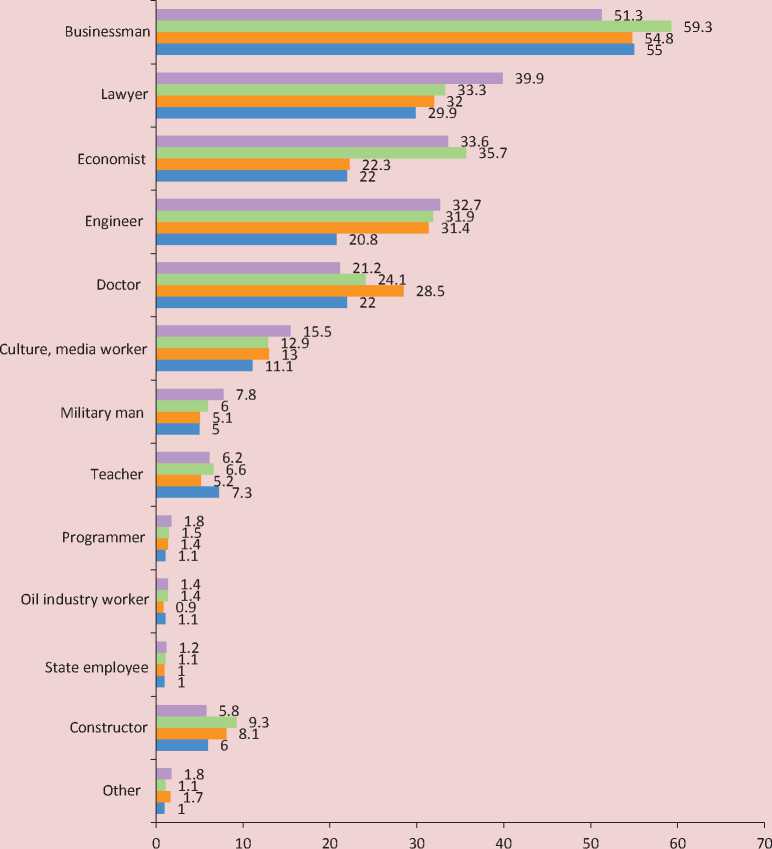
■ Khanty-Mansi AO Surgut ■ Lyantor ■ Nizhnesortymskii
Compiled from the analysis materials of the Socio-Political Analysis and Public Affairs Committee of the Khanty-Mansi Autonomous Okrug Governor’s Office; the results of the author’s sociological research (Surgut, Lyantor, Nizhnesortymskii).
the respondents was made with the focus on the content of their future profession; 15% consider education as the beginning of a future professional activity; 1/3 have not decided on their occupational choice, which may lead to an inconsiderate choice of profession and educational institution.
The Khanty-Mansi Autonomous Okrug is primarily an oil and gas producing territory with a particular geopolitical importance and unique natural resources which provide energy security of the country.
Data in Table 7 indicate, first, lack of both workers with secondary vocational education and specialists with higher professional education; second, this includes not only industry professionals, but other specialists. Nowadays there is a generally increased demand for “blue-collar workers” in the autonomous okrug. The vacancy structure by individual municipal units is 90% blue-collar workers: a car driver (473), a salesman (139), a crane operator (126), a workover assistant driller
(106), a cook (105). Professions in the construction and pharmaceutical industries are also in demand. However, blue-collar jobs are the least popular among young people. According to the data of the Department of Labor and Employment of the Khanty-Mansi Autonomous Okrug, the inconsistency between occupational choice and the needs of the regional labor market leads to the situation where a significant share of graduates at the beginning of their career are forced to become unemployed. Recently, a serious problem has emerged: the structure of professional training in universities reflects the needs of region’s population in diplomas of education of a particular speciality rather than the needs of the economy of the region [13]. It is necessary to intensify career-guidance work in order to form among the graduates the attitude of conscious choice of educational institutions and field of study with regard to the structure of recruitment needs in the labor market in the city, district and
Table 7. Most workforce-scarce economic sectors of the Khanty-Mansi Autonomous Okrug, people
|
Economic sector |
Need for labor resources, people |
|
Mineral extraction |
4054 |
|
Processing industry |
1133 |
|
Transportation and communication |
3154 |
|
Power generation |
2766 |
|
Construction |
2340 |
|
Education |
3483 |
|
Healthcare and social service provision |
7726 |
|
Compiled from: data of the Department of Labor and Employment of the Khanty-Mansi Autonomous Okrug (2015). |
|
Figure 6. Model of high school students’ professional identity
|
Conditions |
Assistance in the development of a proper subject of one’s professional activity |
||
|
Timely assistance and support |
Teaching how to overcome difficulties independently |
Provision of free time |
|
|
Professional identity |
*
(Л
а> га
S га
Е
сл
ш <л
га
<л
ш <л
|
Directions |
Principles |
Directions |
|
Work with students |
Freedom of choice |
Diagnostic |
|
Work with parents |
Consciousness |
Professional education |
|
Teaching staff guidance |
Competence and consistency |
Project activities |
|
Parents’ psychological education |
||
|
Psycho-pedagogical council |
||
|
Teaching staff guidance |
||
|
Approaches |
||
|
Activity |
||
|
Age |
||
|
Personal |
||
|
Psychological |
||
|
Activating |
||
|
High school students’ readiness for professional identity |
||
|
t t t |
||
|
Psycho-pedagogical |
Functions |
Principles |
Diagnostic
Diagnostic minimum

V)
Psycho-pedagogical council
Analytical
Protective-identification
Purposefulness Timeliness Confidentiality Non-evaluativity
Psycho-pedagogical support
|
Consideration of individual characteristics |
Knowledge of age peculiarities |
Consideration of needs and motivation when choosing a profession |
Conditions |
okrug. In this context, comprehensiveness and consistency as fundamental principles of organization of career orientation and support of professional identity of the graduates is reflected in the Concept of professional orientation system development of the autonomous okrug in terms of allocating to the educational institutions the function of creating conditions for a systematical skilled and complex work on career guidance.
The model of professional identity of students developed and implemented by educational institutions allows adjusting the main directions of career guidance: education, diagnostics, counseling, correction (Fig. 6). The student in cooperation with the teacher in the process of projective activity independently designs a personal professional action plan based on specific and realistic goals, interests and abilities, tracks the directions of his/her self-development and determines the final result.
Each generation creates its own ideal model of success in life and proposes its components. The structure of components of success in life helps understand the peculiarities of life strategies of young people’s behavior. Table 8 presents modern young people’s interpretation of the concept “success in life”.
According to the responses, today’s young people have not moved far from their predecessors – they are equally concerned with the choice of purposeful targets which represent success in life. The youth sample draws attention to the frequent selection of such variants as “a well-paid interesting, meaningful job”, “realization of life plans and achievement of goals”. Traditionally,
Table 8. What does “success in life” mean to you?, % (multiple answers)
|
Variant |
2015 |
||
|
Surgut |
Lyantor |
Nizhnesortymskii |
|
|
Happiness in personal life, family well-being |
34 |
28 |
31 |
|
Realization of life plans and achievement of goals |
37 |
42 |
33 |
|
Well-paid interesting, meaningful job |
45 |
53 |
49 |
|
Self-actualization, determination of one’s life purpose |
25 |
32 |
37 |
|
Material well-being, prosperity |
32 |
36 |
34 |
|
Success, career, senior position |
27 |
21 |
26 |
|
Respect, public recognition |
21 |
19 |
11 |
|
Good friends |
35 |
29 |
33 |
|
Education, level of professionalism |
14 |
17 |
14 |
|
Health |
13 |
16 |
21 |
|
Housing issue solution |
14 |
11 |
9 |
|
Independence, self-reliance |
11 |
8 |
4 |
family is highly ranked in terms of success in life as it integrates all its components. The value of family relations is increasing as a family becomes a certain “home front” for young people. Claims to prestige are associated with the employment career; recognition of success among friends and family is becoming important for many respondents. Nowadays the process of formation of an individual-oriented type of person is quite active, utilitarian and pragmatic attitudes among young people are spreading, which are expressed in the desire for material well-being. A rare reference to education as a component of success suggests that it has become a means of achieving other goals for the majority of young people.
Young people tend to explain their failure to realize their life plans by objective circumstances: lack of material resources (38.4%), lack of experience (27.8%), lack of opportunities due to place of dwelling (21.4%). According to young students, personal-subjective qualities are also an obstacle for the achievement of their goals: “lack of motivation” (12.3%), “fear of risk, preference to live in peace” (18.4%). Achieving success is directly linked to the availability of education (43.3%), hard work (32.1%), determination (24.1%), professionalism (45.3%), money (52.3%) and honesty (18.3%). Not least important are resources such as ties to “the right people” (43.2%), i.e. social capital and flexibility – the ability to adapt to various situations (38.4 %).
Thus the process of formation of educational plans and life expectations of young students occurs in the context of a systemic crisis, and is governed by a complex change dynamics. However, most young people’s attitudes are quite optimistic: they are mostly ready for the recognition and solution of problems arising at the regional level. The youth has a significant level of mobility, intellectual activity and health, they act as a social group of the population most adaptable to new conditions. Only a minor part of the youth shows uncertainty about the future and prefers not to make long-term predictions. The study of academic and occupational plans of high school students has shown a contradiction between regional needs for labor force and professional preferences of the youth. Lack of information about occupations in demand in the regional labor market is obvious. The revealed contradictions confirm the relevance of the development of the professional identity formation system of the youth adequate to the structure of the labor market. Only an effective system of professional identity will help expand opportunities of personal and professional self-actualization and successful career options under a conscious social position, and lay the foundation for professional mobility of the graduates of educational institutions.
Список литературы Life strategies of young people: sociological research experience
- Abul’khanova-Slavskaya K.A. Strategii zhizni . Moscow: Mysl’, 1991. p. 67..
- Volokitina A.A. Zhiznennye strategii molodezhi v usloviyakh professional’nogo vybora . Sotsiologiya i zhizn’ , 2010, no. 4, pp. 217-221..
- Golovakha E.I. Zhiznennaya perspektiva i tsennostnye orientatsii lichnosti . Psikhologiya lichnosti v trudakh otechestvennykh psikhologov . Saint Petersburg, 2000. Pp. 266-267..
- Golikova S.V. et al. Gumanitarnye problemy sovremennosti: chelovek i obshchestvo . Novosibirsk: Izdatel’stvo TsRNS, 2014. 248 p..
- Dobren’kov V.I., Kharcheva V.G. Sotsial’naya zashchita naseleniya RF: analiz rezul’tatov sotsiologicheskogo oprosa . Vestnik Moskovskogo universiteta , 1996, no.3, pp. 17-28..
- Zubok Yu.A. Risk v sotsial’nom razvitii molodezhi . Sotsial’no-gumanitarnye znaniya , 2003, no.1, pp. 147-162..
- Lisovskii V.T. Dukhovnyi mir i tsennostnye orientatsii molodezhi Rossii . Saint Petersburg: SPbGUP, 2000. 519 p..
- Naumova N.F. Zhiznennye strategii v perekhodnom obshchestve . Sotsiologicheskii zhurnal , 1995, no. 2, p. 54..
- Leonidova G.V., Ustinova K.A. Zanyatost’ molodezhi kak uslovie modernizatsii sotsial’no-trudovoi sfery . Ekonomicheskie i sotsial’nye peremeny: fakty, tendentsii, prognoz , 2013, no.2 (26), pp. 101-109..
- Leont’ev D.A. Ot sotsial’nykh tsennostei k lichnostnym: sotsiogenenez i fenomenologiya tsennostnoi regulyatsii deyatel’nosti . Vestnik Moskovskogo universiteta. Seriya 14: Psikhologiya , 1996, no. 4..
- Marinov M.B. Transformatsiya strategii zhizni lichnosti v individualiziruyushchem obshchestve . Moscow: Sotsial’no-gumanitarnye znaniya, 2008. p. 41..
- Petrovskii A.V. Obshchaya psikhologiya: slovar’ . Psikhologicheskii leksikon. Entsiklopedicheskii slovar’ v shesti tomakh . Moscow: PER SE, 2006. p. 176..
- Osipova L.B. Zhiznennye perspektivy tyumenskoi molodezhi . Sovremennye problemy nauki i obrazovaniya , 2015, no. 1. Available at: http://www.science-education.ru/121-18242 (accessed 02.04.2015)..
- Prykina L.V., Osipova L.B. Formirovanie zhiznennykh strategii molodezhi . Izvestiya vysshikh uchebnykh zavedenii “Sotsiologiya. Ekonomika. Politika” , 2014, no. 4 (43), pp. 77-81..
- Reznik T.E., Reznik Yu.M. Zhiznennye strategii lichnosti . Sotsiologicheskie issledovaniya , 1995, no. 12, p. 76..
- Rutkevich M.N., Zubok Yu.A., Chuprov V.P. Zhiznennye plany molodezhi . Sotsiologiya molodezhi: entsiklopedicheskii slovar’ . Moscow: Academia, 2009. p. 418..
- Sillaste G.G. Molodezh’. Selo. Bezopasnost’ . Bezopasnost’ Evrazii , 2003, no.4, pp. 4-15..
- Frager R., Fadiman J. Lichnost’: teorii, uprazhneniya, eksperimenty . Saint Petersburg: Praim-Evroznak, 2008. 704 p..
- Hjelle L., Zigler D. Teorii lichnosti. Osnovnye polozheniya, issledovaniya i primenenie . Saint Petersburg: Piter Press, 2008. 607 p..
- Cherednichenko G.A. Molodezh’ Rossii. Sotsial’nye orientatsii i zhiznennye puti . Saint Petersburg, 2004. p. 32..
- Shlapak N.A. Kategoriya “zhiznennye plany” . Filosofskie nauki , 1974, no. 5, pp. 139-142..
- Enveri L.A., Osipova L.A. Zhiznennye strategii sovremennoi molodezhi . Vestnik Vyatskogo gosudarstvennogo gumanitarnogo universiteta , 2012, no. 4 (4), pp. 106-109..

